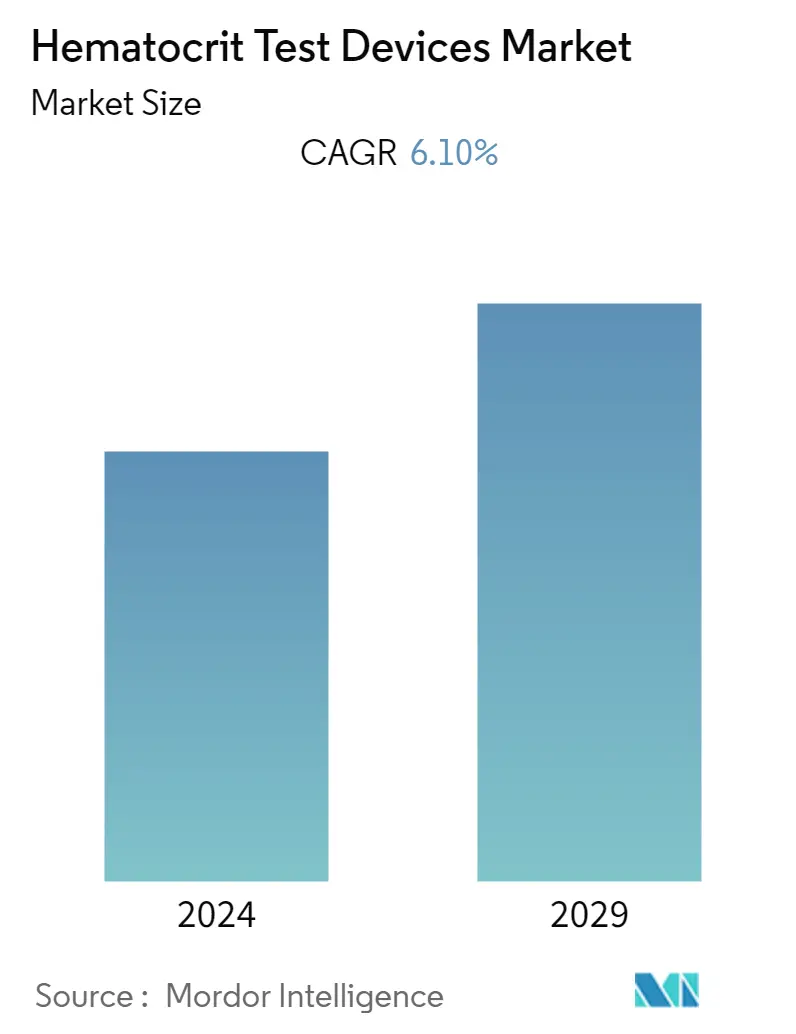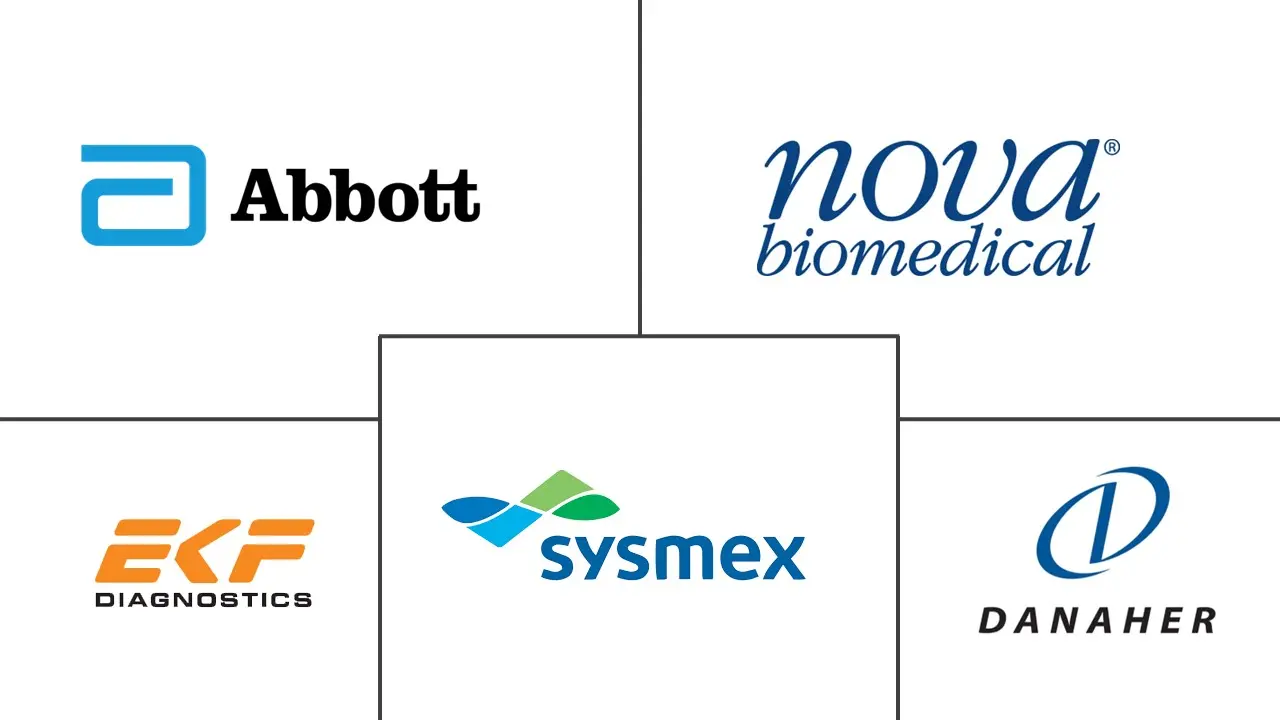Market Size of Hematocrit Test Devices Industry

| Study Period | 2019 - 2029 |
| Base Year For Estimation | 2023 |
| CAGR | 6.10 % |
| Fastest Growing Market | Asia-Pacific |
| Largest Market | North America |
| Market Concentration | Medium |
Major Players
*Disclaimer: Major Players sorted in no particular order |
Hematocrit Test Devices Market Analysis
The hematocrit test devices market is expected to register a CAGR of 6.1% over the forecast period.
The COVID-19 pandemic had a significant impact on the hematocrit test devices market. The blood test used increased during the pandemic to diagnose COVID-19 patients. For instance, according to a study published in the MDPI Journal in November 2021, the clinical course of COVID-19 individuals admitted with mild disease can be tracked using regular hematology tests. Additionally, as per the study published in the NCBI in February 2022, patients with severe COVID-19 showed an increase in hematological changes, indicating a progressive worsening as COVID-19 severity progressed. Hence, it proposed that monitored hematological alterations in patients with COVID-19 played an important role in managing the disease and preventing the risk of a severe course of the disease. Thus, hematocrit testing was increasingly used to identify the physiological alterations in the blood component of COVID-19 patients during COVID-19 and led to significant growth.
The high prevalence of anemia and other blood disorders worldwide is expected to be a major driving factor for the growth of hematocrit test devices. Iron deficiency anemia is a common health problem that affects children under the age of five. For instance, according to a research study published in NCBI in July 2022, the global pooled prevalence (till 2021) of iron deficiency anemia and iron deficiency in children was 16.42% and 17.95%, respectively. Iron deficiency and anemia are very common, especially in Asia and Africa. Therefore, to reduce their complications, regular screening and treatment of iron deficiency and iron deficiency anemia are required, especially in high-risk children. Thus, the significant burden of anemia globally is expected to spur the demand for hematocrit test devices, thereby boosting the market.
The increasing geriatric population is further expected to augment the demand for hematocrit tests as they are more prone to chronic diseases and often require routine checkups. According to the United Nations World Population Prospects 2022, the share of the global population aged 65 years or above is projected to rise from 10% in 2022 to 16% by 2050. It is also estimated that, by 2050, the number of persons aged 65 years or over worldwide is projected to be more than twice the number of children under age five and about the same as the number of children under age 12. Thus, the increasing geriatric population worldwide is likely to create demand for blood tests, ultimately contributing to the market's growth.
However, stringent regulations regarding test devices and less awareness about the hematocrit test are expected to restrain the growth of the market during the forecast period.
Hematocrit Test Devices Industry Segmentation
As per the scope of the report, a hematocrit test is part of a complete blood count that measures different components of the blood. Hematocrit test helps in diagnosing blood disorders such as anemia, polycythemia vera, and others. The hematocrit is typically measured from a blood sample by an automated machine that makes several other measurements of the blood at the same time.
The hematocrit test devices market is segmented by product (hematocrit test meter, hematocrit test analyzer, and reagents and consumables), application (anemia, polycythemia vera, congenital heart disease, and other applications), end user (hospitals, diagnostic centers, and other end users), and geography (North America, Europe, Asia-Pacific, Middle East and Africa, and South America). The report also covers the estimated market sizes and trends of 17 countries across major regions globally. The report offers values (in USD million) for the above segments.
| By Product | |
| Hematocrit Test Meter | |
| Hematocrit Test Analyzer | |
| Reagents and Consumables |
| By Application | |
| Anemia | |
| Polycythemia Vera | |
| Congenital Heart Diseases | |
| Other Applications |
| By End User | |
| Hospitals | |
| Diagnostic Centers | |
| Other End Users |
| By Geography | ||||||||
| ||||||||
| ||||||||
| ||||||||
| ||||||||
|
Hematocrit Test Devices Market Size Summary
The hematocrit test devices market is poised for significant growth, driven by the increasing prevalence of anemia and other blood disorders globally. The demand for these devices is further bolstered by the rising geriatric population, who are more susceptible to chronic diseases and require regular blood tests. The COVID-19 pandemic also played a pivotal role in expanding the market, as hematocrit testing became essential for monitoring patients' blood conditions, thereby highlighting its importance in clinical settings. Despite the positive growth trajectory, the market faces challenges such as stringent regulatory requirements and limited awareness about hematocrit testing, which could potentially hinder its expansion.
North America is anticipated to maintain a substantial share of the hematocrit test devices market, attributed to the region's high incidence of blood disorders and an aging population. The United States, in particular, is expected to dominate this regional market due to its advanced healthcare infrastructure and significant burden of anemia. The market's competitive landscape is characterized by the presence of key players like Abbott Laboratories, Sysmex Corporation, and Danaher Corporation, who are actively introducing innovative products to enhance their market position. These developments, coupled with government initiatives to raise anemia awareness, are expected to drive the demand for hematocrit test devices, supporting the market's growth over the forecast period.
Hematocrit Test Devices Market Size - Table of Contents
-
1. MARKET DYNAMICS
-
1.1 Market Overview
-
1.2 Market Drivers
-
1.2.1 Rising Prevalence Rates of Anemic Conditions
-
1.2.2 Growing Geriatric Population with Blood Disorders
-
-
1.3 Market Restraints
-
1.3.1 Stringent Regulatory Approvals and Lack of Awareness About Hematocrit Test
-
-
1.4 Porter's Five Forces Analysis
-
1.4.1 Threat of New Entrants
-
1.4.2 Bargaining Power of Buyers/Consumers
-
1.4.3 Bargaining Power of Suppliers
-
1.4.4 Threat of Substitute Products
-
1.4.5 Intensity of Competitive Rivalry
-
-
-
2. MARKET SEGMENTATION (Market Size by Value - USD million)
-
2.1 By Product
-
2.1.1 Hematocrit Test Meter
-
2.1.2 Hematocrit Test Analyzer
-
2.1.3 Reagents and Consumables
-
-
2.2 By Application
-
2.2.1 Anemia
-
2.2.2 Polycythemia Vera
-
2.2.3 Congenital Heart Diseases
-
2.2.4 Other Applications
-
-
2.3 By End User
-
2.3.1 Hospitals
-
2.3.2 Diagnostic Centers
-
2.3.3 Other End Users
-
-
2.4 By Geography
-
2.4.1 North America
-
2.4.1.1 United States
-
2.4.1.2 Canada
-
2.4.1.3 Mexico
-
-
2.4.2 Europe
-
2.4.2.1 Germany
-
2.4.2.2 United Kingdom
-
2.4.2.3 France
-
2.4.2.4 Italy
-
2.4.2.5 Spain
-
2.4.2.6 Rest of Europe
-
-
2.4.3 Asia-Pacific
-
2.4.3.1 China
-
2.4.3.2 Japan
-
2.4.3.3 India
-
2.4.3.4 Australia
-
2.4.3.5 South Korea
-
2.4.3.6 Rest of Asia-Pacific
-
-
2.4.4 Middle East and Africa
-
2.4.4.1 GCC
-
2.4.4.2 South Africa
-
2.4.4.3 Rest of Middle East and Africa
-
-
2.4.5 South America
-
2.4.5.1 Brazil
-
2.4.5.2 Argentina
-
2.4.5.3 Rest of South America
-
-
-
Hematocrit Test Devices Market Size FAQs
What is the current Hematocrit Test Devices Market size?
The Hematocrit Test Devices Market is projected to register a CAGR of 6.10% during the forecast period (2024-2029)
Who are the key players in Hematocrit Test Devices Market?
Abbott Laboratories, EKF Diagnostics, Nova Biomedical, Sysmex Corporation and Danaher Corporation are the major companies operating in the Hematocrit Test Devices Market.

